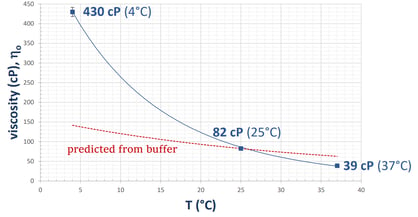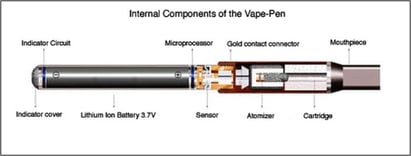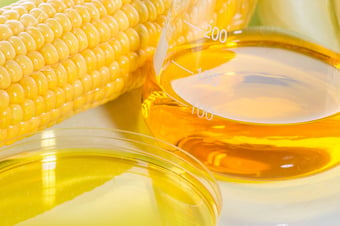Temperature has a huge impact on viscosity. Your sample at higher temperatures may have a totally different viscosity compared to the same sample at lower temperatures. Viscosity reflects the molecular behavior of your samples (size, shape, interactions, microstructure), and therefore varying temperature during viscosity measurements can be very revealing and provide information about the fluid microstructure.
So, we understand that viscosity changes with temperature, but why does viscosity change with temperature? Viscosity reflects what is happening on the molecular level, and according to the kinetic theory of matter: molecules/ particles are in continual motion. The motion of these particles is dependent on temperature (among other factors) in the form of thermal and kinetic energy, which determines velocity particle travels. Increasing temperature will increase energy, and therefore the velocity of the particles. Viscosity will decrease with increased temperature because as particles move more quickly, they interact for shorter time (shorter interactions) reducing internal friction or stress and therefore decreasing viscosity.

Temperature also influences interactions of particles. For example, change in temperature will impact how the solute and solvent particles interact. It also impacts both inter and intra molecular interactions. For example, if a protein denatures as function of temperature intra-molecular interactions are disrupted. This same denaturation will also influence how that protein molecule interacts with other particles in a solution (intermolecular). Samples prone to aggregation or denaturation will behave very differently than stable fluids or those undergoing microphase separation.

Measuring, and understanding, viscosity at various temperatures is essential for formulation of various applications. Drastic changes in viscosity with temperature greatly impacts complex formulations such as engine oil, antibody based therapeutics, cannabis oils, personal care products and of course example we can all observe for ourselves – food (cooking oil, syrup, honey). When you cook with butter or cooking oil you can see a drastic change in the viscosity when you put either substance in a hot pan. The viscosity decreases with the higher temperatures, making it easier to spread the oil or butter around to coat your entire pan.
Understanding temperature dependent measurements of antibody therapeutics is crucial for formulation and stability. These therapeutics are stored at cool temperatures for stability, delivered at room temperature, and then distributed into body at elevated body temperature. Understanding how they will behave at each of these temperatures will help to formulate for optimal stability, efficacy and patient experience.

Another common and very important example of a temperature dependent viscosity application is cannabis oil. When formulating cannabis oils to be used in vaporizer, or “vape pens”, you must consider both temperature and viscosity. These pens contain a heating element heats the oil to a precise temperature that is below combustion, but high enough to vaporize the oil and to not burn it. The viscosity of the oil must also be high enough as to not flow too quickly leading to flooding of the heating element but must not be too high or the oil will clog the cartridge.
VROC® (Viscometer-Rheometer-on-a-Chip) combines microfluidic and MEMS (Micro-Electro-Mechanical Systems) technologies to measure dynamic viscosity over a wide dynamic range of operation. Our VROC chips contain a microfluidic channel with pressure sensors, providing controlled strain or controlled rate. With VROC we control the volumetric flow rate, and therefore the shear rate, of the sample and then monitor stress by calculating pressure change (drop) across the channel. With RheoSense VROC technology allows you to run the temperature sweeps you need to obtain precise measurements for all of your formulations.
Want to learn more about temperature dependent viscosity measurements? Download our FREE webinar recording to learn more about how you can use viscosity measurements at various temperatures to determine microstructure of your samples.
Written by: Eden Reid, RheoSense Senior Marketing and Sales Operations




